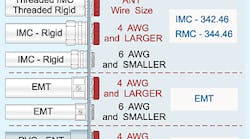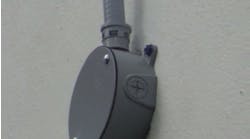Apparently the Code was more confusing than we thought. After lying dormant for months, Code Quandaries is back, and Mike Holt, EC&M's NEC Consultant, is here to answer your most difficult questions. Need some help with an installation? Clashing with your local inspector? E-mail Mike with a description of the situation at [email protected], and your question may show up in a future column.
Q. An inspector told me that insulating bushings are only required for raceways sized 1 in. or larger with the exceptions of IMC and rigid conduit. I can't find any reference to this in the NEC.
A. According to 300.4(F), a fitting that provides a smoothly rounded insulating surface is required for raceways that contain ungrounded conductors 4 AWG or larger. The exception states that an insulating bushing isn't required where the raceway terminates with a threaded entry, such as a hub (Fig. 1).
Q. When installing fluorescent lights on drywall ceilings, can I run NM cable through the drywall directly to the fixture marked “Suitable for use as a Junction Box,” or is a junction box required?
A. An enclosure is required at each conductor splice point (300.15). Since the fixture is listed as suitable as a junction box, this is fine, as long as you terminate the cable with a cable connector.
Q. Please clarify the requirements of 110.26(F)(1)(c). What does “Sprinkler protection shall be permitted for the dedicated space where the piping complies with this section” mean?
A. This is a confusing way of saying that the piping of the sprinkler protection system is permitted in the room, but it isn't permitted to be installed within the dedicated electrical space. Dedicated space is equal to the width and depth of the equipment, extending from the floor to a height of 6 ft above the equipment or to the structural ceiling, whichever is lower [110.26(F)(1)(a)].
Q. I'm installing an air compressor, and the instruction manual states, “We only recommend dual element time delay fuses for unit protection.” Can an inverse time circuit breaker be installed instead of the fuse protection?
A. You can use a circuit breaker, but it might not hold during the startup cycle. It's true that 110.3(B) requires listed or labeled equipment to be installed and used in accordance with any instructions included in the listing or labeling, but recommendations in an instruction manual aren't part of the “instructions included in the listing or labeling.”
Q. Can I place receptacles and luminaires on the same branch circuit?
A. Receptacles and luminaires can be placed on the same general-purpose branch circuit in both residential and commercial occupancies. However, the Code prohibits you from locating luminaires on small appliance, laundry, or bathroom receptacle circuits in dwelling units [210.11(C)]. In addition, 527.4(D) prohibits you from installing receptacles on branch circuits that supply temporary lighting on construction sites.
Where a 20A circuit supplies a single bathroom in a dwelling unit, outlets for other equipment in the same room can be on the bathroom circuit [210.11(C)(3) Exception].
Q. I found splices inside a panelboard. Could you please direct me to the Code section that permits this practice?
A. Splices within a cabinet shall not fill the wiring space at any cross section to more than 75% of the cross-sectional area of that space (312.8). How can you calculate this splice fill percentage? Practically speaking, if you're not praying that they will be a short, you should be fine when replacing the cover.
Q. I have a parallel feed to a meter. If I use parallel lugs, can I go directly from the meter to two separate 200A main breaker panels?
A. Yes you can, but you must group the two disconnects together in accordance with the requirements of 230.72.



